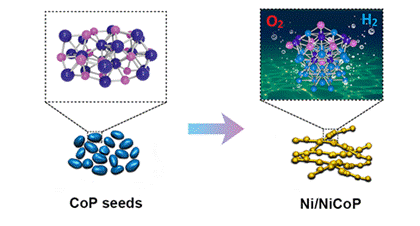| Multi-dimensional Ni/NiCoP core-shell heterostructure for water electrolysis: morphology effect and electronic structure effect |
| From: PublishDate:2020-07-24 Hits: |
Electrolyzing water to produce hydrogen is an ideal method. However, the energy consumption for water electrolysis is high, which is less competitive than that of hydrogen production by fossil fuel. The key to reduce the total energy consumption and improve the efficiency is developing a high efficient electrocatalyst. A research group in the School of Material Science and Engineering of China University of Petroleum (East China) constructed Ni/NiCoP heterojunction with multi-dimensional core-shell structure and used it on full water electrolysis, and the structure-activity relationship was studied in depth. Their research has been published on December 15, 2019 in Applied Catalysis B: Environmental. Ni metal has similar moderate hydrogen binding energy to Pt, bulk Ni metal is not an ideal HER or OER catalyst especially in acid due to the easy dissolution, introducing P atoms to the metal Ni can prevent this. Template conversion using CoP nanoparticles as crystal seeds was used to synthesize multi dimensional core-shell heterogeneous structure of Ni/NiCoP catalyst, in which, metallic Ni nanoparticles (NPs) are enclosed and strung by NiCoP, forming strings of Ni/NiCoP core/shell nanostructures. This particular structure takes the most of advantages of Ni metal and bimetallic phosphides nanostructures, but also avoids the disadvantages ((Ni has high conductivity, but it is unstable in acid; bimetallic phosphides have high activity and stability, but its conductivity is limited). Then both of the activity and the stability are elevated. Basing on the X-ray absorption spectrum carried out 1W1B-XAFS station of Beijing Synchrotron Radiation Facility (BSRF), they find that there exist strong electron transfer from Ni cores to bimetallic NiCoP in this multi-dimensional nano-heterojunctions, which producing peculiar electron effect, benefiting the whole water electrolysis.
Article: Yan Lin#, Kaian Sun#, Shoujie Liu#, Xiaomeng Chen, Yuansheng Cheng, Weng-Chon Cheong, Zheng Chen, Lirong Zheng, Jun Zhang*, Xiyou Li, Yuan Pan*, Chen Chen*. Construction of CoP/NiCoP Nanotadpoles Heterojunction Interface for Wide pH Hydrogen Evolution Electrocatalysis and Supercapacitor,Adv. Energy Mater.,2019, 9, 1901213. |
|
|
| Chinese
- Metal-free efficient photocatalyst for stable visible water splitting——Top ten major scientific progresses in China in 2015
- The nano-resolution imaging platform was awarded the first rate prize of Beijing Science and Technology in 2014
- Beamline 1W1 of BSRF started to runoperate in the couplingparasitic mode of BEPCII
- Synthesis of High Performance Polymer Materials for Field Effect-Transistors
- Surfactant molecular aggregates in green solvents
- GIXRD has played an important role in the characterization of organic thin-film transistors
Science Highlights
Home /
Copyright © 2011 - 2012 Beijing Synchrotron Radiation Facility


